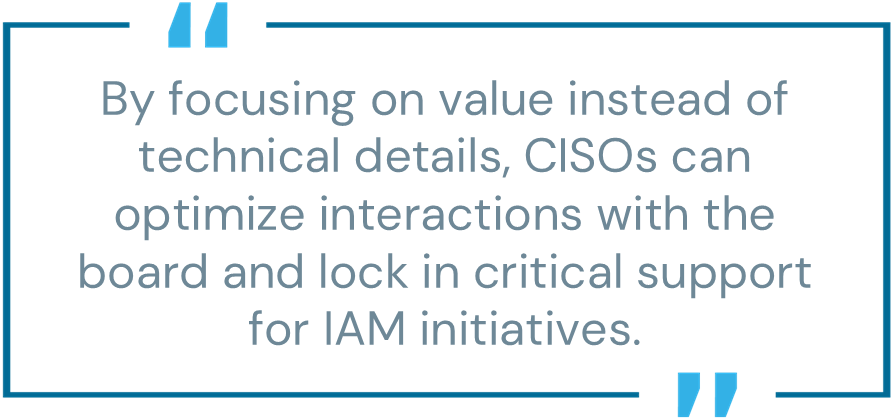
In a time when 94% of companies have experienced an identity-related breach, many CISOs feel the urgency to strengthen identity and access management (IAM) across their organizations. In fact, a recent survey of CISOs found that identity is the top focus area going into 2025. However, communicating IAM’s value to the board remains a challenge—it isn’t enough for these security leaders to craft effective IAM strategies—they must also secure their board’s support.
CISOs know that executive buy-in is critical for obtaining the necessary funding and setting the right tone from the top. The problem is that many still struggle to communicate IAM’s value in “dollars and cents” business terms that the board and C-suite can easily understand.
The good news is that CISOs and their boards are communicating more than ever. By focusing on value instead of technical details, CISOs can optimize these interactions and lock in critical support for IAM initiatives.

The following guide is designed to help CISOs anticipate tough questions, overcome objections and successfully articulate IAM program value to their boards and executive teams.
Frame IAM as a Strategic Business Investment—Not a Security Purchase
This approach aligns the IAM investment directly with business priorities, showing how it can drive measurable business value.
Talking Point: IAM will directly contribute to our organization’s broader mission.
Describe how this IAM program is an essential step in achieving business outcomes such as reducing operational risk and supporting digital transformation.
Communicate how it will also help meet key business requirements. For instance, as an organization within a much broader digital ecosystem, we are not immune to surging supply chain risks. Our customers and business partners will continue to scrutinize our security posture and demand assurances that our practices are sound.
Show how this IAM program is a strategic way to enforce broad, risk-mitigating controls that, most importantly, secure and advance the business and, consequently, meet the necessary compliance requirements of our partners, customers and regulators.
Talking Point: This IAM program strategically supports our growth by balancing protection and operational needs.
No organization is immune to cyberattacks—and this program isn’t about preventing every potential breach. Instead, convey that it’s about creating sustainable, common-sense controls that balance protection, business agility and customer experience.
Demonstrate IAM Value Through Measurable Metrics
C-level executives must see quantifiable benefits. To demonstrate how the IAM program will deliver value, develop goals to help quantify the specific level of protection at a given cost. Use outcome-based metrics to demonstrate that IAM is a value—and trust-generating investment for the organization that will improve business outcomes.
Measurable Metric: The Cost of Doing Nothing
Calculate the potential financial losses from a security incident due to inadequate IAM controls, such as the lack of controls over privileged accounts. Do so by providing benchmarks for how IAM reduces help desk support costs, accelerates user provisioning through automation and improves productivity with modern access management.
It’s also impactful to highlight the unacceptable business outcomes that could stem from inadequate controls, such as stolen customer data or downtime due to ransomware.
Measurable Metric: ROI and Operational Savings
Demonstrate how automation significantly streamlines IAM processes and costs, promoting proven standards and operational efficiencies by avoiding new FTEs. For example, automating access reviews and reducing manual intervention can lead to significant time and cost savings.
Align IAM with Specific Security and Business Outcomes
CISOs are responsible for ensuring—and communicating—that the IAM initiative aligns with both security and business objectives. Doing so allows the board to view IAM as an asset—rather than an expense. Link specific security efforts to specific business outcomes to clearly demonstrate how IAM supports organizational goals.
Persuasion Technique: Speak to Specific Stakeholders
Present IAM in terms of its impact on specific stakeholders like shareholders, customers and regulatory bodies. For instance, illustrate how proficient IAM can improve customer trust, satisfy regulatory requirements and increase organizational resilience—connecting these enhanced business outcomes with deeper stakeholder satisfaction.
Persuasion Technique: Emphasize IAM Flexibility
Highlight how IAM solutions can be tailored by the business to meet specific protection levels, effectively balancing cost with business risk tolerance.
Highlight IAM’s Long-Term Competitive Advantage and Resilience
Identity security is not just about protecting the business today—it’s about future-proofing company investments against evolving threats. It’s also important to show how robust identity security can sharpen competitive advantage by ensuring agility to adapt to new business models, partnerships and regulatory environments.
Priority Phrase: IAM and Business Agility
The proposed strategy should clearly show executive leadership how IAM supports organizational digital transformation efforts, such as cloud migration, remote work and third-party collaborations. It should position identity security as a key enabler of innovation and growth.
Priority Phrase: IAM and Risk Reduction
The CISO narrative must highlight (at a high level) long-term risk-reduction plans that will enable business flexibility. To do this, demonstrate how identity security can minimize potential disruptions in conjunction with other technologies such as cloud and data protection. This will show how integrated your plan is with a definition of cybersecurity mesh architecture (CSMA) without going too far into technical minutia.
Priority Phrase: IAM Value
Of course, the most common barrier to security program approvals is the perception of cost and complexity. To alleviate these concerns, stay focused on value and take every opportunity to demonstrate the trade-offs in terms of protection level and business growth. Emphasize that IAM investments can be scaled to meet organizational budget thresholds while still delivering measurable value.
Success is Where Preparation and Opportunity Meet
Savvy security leaders understand that every board interaction is an opportunity to shape a winning cybersecurity strategy, and they go to great lengths to prepare. They recognize that what they say—and how they say it—matters, translating technical details into a straightforward, concise business narrative.
By possessing a deep understanding of business goals and board priorities, CISOs can build a compelling case for identity security by articulating not only how it will reduce cybersecurity risks, but also deepen customer trust, balance costs, drive business growth and, ultimately, create a more secure future for the organization. By effectively communicating the value of IAM to the board, CISOs can secure the necessary buy-in and funding to implement robust identity and access management strategies.
Claudio Neiva is CyberArk’s Security Strategic Advisor and Director (LATAM).





















